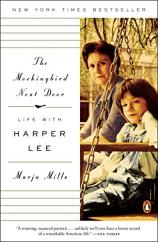The Mockingbird Next Door: Life with Harper Lee
Review
The Mockingbird Next Door: Life with Harper Lee
Please note: Shortly after this review was submitted to us, Harper Lee released a letter denying any cooperation with the book. In part she says, "Rest assured, as long as I am alive any book purporting to be with my cooperation is a falsehood." Click here to read all about the controversy in Gawker's article, "How Unauthorized Is the New Book About Harper Lee?”
There is a pantheon of famous writers who only wrote one novel --- Boris Pasternak, Emily Bronte and Margaret Mitchell --- to name but three, and reclusive writers, such as Proust, Salinger and Pynchon. On both lists you would find the author of one of America’s best-known and most admired novels, TO KILL A MOCKINGBIRD. Marja Mills, a skilled journalist with a friendly manner, managed to penetrate the private world of Nelle Harper Lee, living next door to her for over a year in Lee’s hometown of Monroeville, Alabama.
Speculation about Lee’s bio always includes the assumption that TO KILL A MOCKINGBIRD was drawn from her own childhood and surroundings, and that her heroine, a plucky, fanciful girl named Scout, was the avatar of Lee, a tomboy who loved books. Scout had a friend named Dill, a sensitive, highly intelligent boy; Nelle had a friend named Truman Capote. Scout had a lawyer father, Atticus, a brooding widower with a unique sense of legal and moral fairness that extended even to Negros in Maycomb, a small southern town, in the Jim Crow era; Lee’s father, A.C., was an attorney in their hometown of Monroeville; and until a few years ago, her older sister Alice, possibly the model for Scout’s brother, Jem, also practiced law.
"THE MOCKINGBIRD NEXT DOOR gives a sense of how attached Harper Lee is to the town and the culture that she has long inhabited."
In response to these autobiographical ticklers, Mills evinced from Nelle this tidbit: “The truth is always a better story.” For someone to whom words were always carefully chosen, that is a mouthful. One of the more interesting turns in the book concerns Nelle’s close but unconventional relationship with Capote. At first she recounts what a strange little boy he was, then gradually gears up to a declaration that she now considers him, by her definition, a “psychopath.”
Much of the Harper Lee story came to Mills from Alice and from friends in the local area. While Alice allowed Mills to record many hours of her family recollections, Nelle took a more spontaneous approach, taking her to feed ducks or have lunches at a local café named Radleys for the mysterious spectral figure in TO KILL A MOCKINGBIRD. That touch is just one reminder of how much publicity has dogged Lee throughout her life, as the author of a bestselling and still widely studied novel that was made into an equally famous film. No wonder then that she retreated, and those who tried to ferret out her story were turned away, and not gently.
For that reason, Mills’s book is remarkable, even if it does not come quite near enough to answering questions that hover around the legendary Lee, and even if at times it seems as much about Mills as about her elusive subject. THE MOCKINGBIRD NEXT DOOR gives a sense of how attached Harper Lee is to the town and the culture that she has long inhabited. So much at home there that, as Mills notes, the locals pay her the courtesy of pretending she is nobody special.
Reviewed by Barbara Bamberger Scott on July 18, 2014
The Mockingbird Next Door: Life with Harper Lee
- Publication Date: May 5, 2015
- Genres: Memoir, Nonfiction
- Paperback: 304 pages
- Publisher: Penguin Books
- ISBN-10: 0143127667
- ISBN-13: 9780143127666





